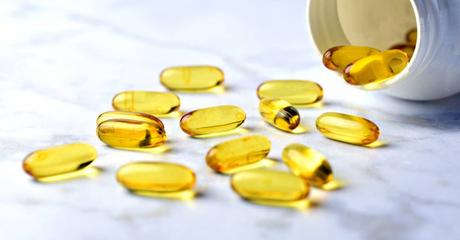
- Omega−3 fatty acids also called Omega-3 oils, are polyunsaturated fatty acids characterized by the presence of a double bond in chemical structure.
- It is a type of fat that the body cannot make on its own. They are an essential fat, needed to survive.
- They are widely distributed in nature and play an important role in the human diet and in human physiology.
The three types of omega−3 fatty acids,
- α-linolenic acid (ALA), found in plant oils,
- Eicosapentaenoic acid (EPA)
- Docosahexaenoic acid (DHA), these both commonly found in fish.
- Common sources of plant oils containing ALA are walnut, algal oil, flaxseed oil, edible seeds, clary sage seed oil, Echium oil, and hemp oil, sources of animal omega−3 fatty acids EPA and DHA are fish, fish oils, and an egg from chickens, squid oils and krill oil.
- Mammals are obtained omega -3 fatty acid from diet.
- Dietary supplementation with omega−3 fatty acids does not increase the risk of death, cancer, or heart disease in people.
BEST SOURCE OF OMEGA – 3 FATTY ACID
Fishes are the best source of omega-3 fatty acids. Some plants also contain omega-3 fatty acids.
Mackerel fish
- Mackerel is a small, fatty fish that people commonly eat-in breakfast.
Mackerel fish contains:
- 0.59 g of DHA
- 0.43 g of EPA
- It is also rich in selenium and vitamin B-12
Salmon
- Salmon fish is the most popular and highly nutritious fish. There are differences between wild and farmed salmon fish, including some variations in the omega-3 content:
- Farmed salmon fish contains:
- 1.24 g of DHA
- 0.59 g of EPA
Wild salmon contains:
- 1.22 g of DHA
- 0.35 g of EPA
- Salmon fish also contains high levels of protein, selenium, magnesium, potassium, and vitamin B.
Seabass
- It is the most popular Japanese fish.
Seabass contains:
- 0.47 g of DHA
- 0.18 g of EPA
- It also provides protein and selenium.
Oysters
- Oysters serve as an appetizer or snack in restaurants.
Oysters contain:
- 0.14 g of ALA
- 0.23 g of DHA
- 0.30 g of EPA
- Oysters also rich in zinc and vitamin B-12.
Sardines
- Sardines are small, oily fish that people can eat as a snack or appetizer.
- 0.74 g of DHA
- 0.45 g of EPA
- It is a good source of selenium and vitamins B-12 and vitamin D.
Shrimp
Shrimp fish contains:
- 0.12 g of DHA
- 0.12 g of EPA
- It is also rich in protein and potassium.
Trout
- Trout are the most popular and healthful fish.
Trout fish contains:
- 0.44 g of DHA
- 0.40 g of EPA
- It is a good source of protein, potassium, and vitamin D
Seaweed and algae
- Seaweed and algae are the sources of omega-3 for vegetarian people, they are one of the few plants that contain DHA and EPA.
- The DHA and EPA content varies depending on the type of algae.
- There are many ways to include these foods in your diet. E.g.;
- Seaweed is a tasty, crispy snack.
- Seaweed is rich in protein,
- Seaweed has anti-diabetic, anti-oxidant, and anti-hypertensive properties.
Chia seeds
- Chia seeds are a good plant-based source of ALA omega-3 fatty acids.
- Rich in fiber and protein.
- People can use these seeds as an ingredient in salads, smoothies, or they can mix them with milk or yogurt to make chia pudding.
Hemp seeds
- Hemp seeds are rich in many nutrients, including:
- Protein
- Magnesium
- Iron
- Zinc
- Studies show that hemp seeds are good for a person’s heart, digestion, and skin.
- Hemp seeds are slightly sweet in taste.
Flaxseeds
- They are rich in;
- Fiber
- Protein
- Magnesium
- Manganese
- These seeds reduce blood pressure and improve heart health.
Walnuts
- Walnuts are a great source of healthy fats, including ALA omega-3 fatty acids.
- People can eat walnuts on their own, in granola, snack bar, yogurt, salad, or cooked dish.
Edamame
- Edamame beans are immature soybeans that are popular in Japan. They are not only rich in omega-3s but also a great source of plant-based protein. Boiled edamame beans eat as a salad or as a side dish.
Kidney beans
- Kidney beans contain 0.10 g of ALA.
- Kidney beans are one of the most common beans include in meals or eat as a side dish.
- People can add them to curries or eat them with rice.
Soybean oil
- People use soybean oil for cooking.
- The oil is also a good source of:
- Riboflavin
- Magnesium
- Potassium
- Folate
- Vitamin K
- People serve soybeans as part of a meal or in a salad.
How omega-3 Fatty Acids help to improve health
- Study shows that omega-3 fatty acids improve cardiovascular health. Most research involves that EPA and DHA improve health but ALA can also help to improve health.
- Benefits omega-3 fatty acids including in your diet;
- Reduced risk of cardiovascular disease and death due to cardiovascular disease,
- Reduced risk of sudden cardiac death caused by an abnormal heart rhythm.
- Omega-3 fatty acids help to prevent blood platelets from clumping together and reduce the risk of blood clots.
- It helps to keep the lining of the arteries smooth and free from damage. This helps to keep away plaque from forming in the arteries.
- Lowering the levels of triglycerides by slowing the rate they form in the liver. High levels of triglycerides in the blood increase the risk of heart disease.
- Less inflammation – Omega-3 fatty acids show inflammatory response and slow the production of substances that are released during the inflammatory response.
- Raise levels of high-density lipoprotein.
- Lower blood pressure.
